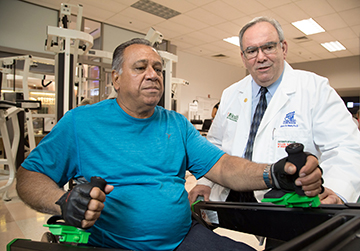A lifestyle intervention diabetes prevention program for SCI is something that Miami Project researchers have been looking into for many years. Everyone knows that being overweight poses risks for heart disease and Diabetes. However, anyone who’s tried to lose weight knows it’s no easy task. There is no miracle pill for losing weight. Of course, there are all kinds of fad diets and supplements, but it’s pretty important that weight loss occurs healthily and that typically involves some combination of exercise, diet, will power, and perseverance. Now let’s add spinal cord injury (SCI) into the equation. Obviously, one of the biggest consequences of SCI is muscle paralysis, and the higher the level of injury the more muscles are paralyzed. This is problematic in two ways: 1) fat is easily deposited in muscles that are not moving, which increases the amount of fat mass in the body, and 2) it’s hard to exercise paralyzed muscles, which makes it more difficult to lose weight by exercise alone. Other consequences of SCI may be less obvious; for example, SCI alters the way your body controls the metabolism of food, which can lead to unhealthy levels of sugars and lipids circulating in your blood. This can lead to an even greater risk of developing heart disease and Diabetes. On top of all of that, it takes more effort and more time to do everything while living with SCI. What to do?
A few years ago, the National Institutes of Health (NIH) funded a large multicenter trial comparing a Diabetes Prevention Program to a standard of care medication therapy for non-disabled people at risk of developing type-2 Diabetes. That trial was so effective it was stopped early, which almost never happens in clinical trials unless the benefit of treatment is so substantial that NIH wants to fast-track the treatment for widespread use! Dr. Mark Nash and colleagues were recently funded by the Department of Defense to test a modified version of this Diabetes Prevention Program in people living with SCI. We’ll call it a Lifestyle Intervention Program for SCI.
Components of the Lifestyle Intervention Program:
First 6 months
- Supervised exercise intervention
- An upper extremity circuit resistance training program performed 3 days each week
- Nutritional intervention
- A calorie-restricted Mediterranean-style diet
- Behavioral intervention
- A 16-session protocol targeting behavioral changes through education, problem-solving skills, and cognitive restructuring
Second 6 months
- Self-care (unsupervised) extension phase maintenance program
Behavioral intervention topics:
Session
- Introduction to lifestyle intervention. Explain study goals.
- Introduce self-monitoring of weight at home.
- Teach three ways to eat less fat.
- Educate about healthy eating. Recommend alternate foods.
- Introduce physical activity modules.
- Tailor physical activity regimen to needs of the individual.
- Teach principles of energy balance between calories and exercise. Teach principles of health maintenance from exercise.
- Introduce principles of stimulus control as a method to prevent unhealthy eating. Introduce principles of stimulus control as a method to maintain exercise adherence.
- Present five-step model of problem-solving.
- Introduce basic skills for eating and exercising away from home.
- Practice identifying negative thoughts and how to counter them.
- Introduce concept that slips are part of lifestyle change and provide tips for behavioral change maintenance.
- Introduce principles of aerobic fitness and coping with boredom.
- Provide strategies for managing social cues, both stressful and supportive.
- Summarize stress management principles presented over the course of the intervention.
- Focus on enhancing motivation and maintaining behavioral change post-lifestyle intervention.
The team recently published results from three of the participants (Bigford et al., 2017), all men with chronic paraplegia who were overweight. All three of the participants experienced a greater than 7% reduction in body mass, which was the primary study goal, and were able to maintain that loss in the maintenance phase of the program. This benefit was associated with a reduction in fasting sugar and triglyceride levels in the blood. These are all important factors to reduce regarding the risk of developing Diabetes. Furthermore, the exercise program was able to increase upper extremity strength and improve cardiorespiratory fitness – important for reducing fatigue and accomplishing activities of daily living. More data on a larger population will be forthcoming, but these initial results are very encouraging, and the first to show that people with SCI could substantially reduce their risk for Diabetes!
Article – Gregory E Bigford, Armando J Mendez, Luisa Betancourt, Patricia Burns-Drecq, Deborah Backus, and Mark S Nash. (2017). A lifestyle intervention program for successfully addressing major cardiometabolic risks in persons with SCI: a three-subject case series. Spinal Cord Series and Cases 3, 17007; doi:10.1038/scsandc.2017.7.

